This page describes in details how heights of a stone crown, girdle and pavilion are calculated by the system.
All the information below considers stone orientation "Table on the top."
Heights Calculation
Points on Girlde Curves
Before calculation, some points should be found:
- Crown bezel point
- Crown bone point
- Pavilion bezel point
- Pavilion bone point
- Pavilion height point
- Pavilion upperbone point
Where Points are Found
If in the given direction:
- There is no extra facet adjacent to the girdle, the points are found simply on the current model ("on real stone") as described in sections of this page.
- There is an extra facet adjacent to the girdle, the points are found:
- For Crown height and Pavilion depth - on a virtual model
- For all girdle heights - on the current model ("on real stone") as described in sections of this page and on a virtual model, see Girdle Heights Calculation Methods
Building a virtual model when calculating Crown height
If there are extra facets on the girdle, a virtual model without these facets is created and used for the measurement. To build the virtual model, the extra facets are removed and the neighboring facets are continued until they intersect.
Building a virtual model when calculating Pavilion depth
If there are extra facets on the girdle, a virtual model without these facets is created and used for the measurement. To build the virtual model, the extra facets are removed and the neighboring facets are continued until they intersect.
Finding Points
Crown Bezel Point and Point for Calculating Crown height
In a simple case, a vertex of the crown main facet that belongs to the girdle upper curve will be a crown bezel point. It will also be used for calculating the Crown height .
In case, when the crown main facet does not meet the girdle, the lowest vertex (main facet edge point) forms +/- 6° range, the highest in this range point on the girdle upper curve will be a crown bezel point. It will also be used for calculating the Crown height .
The case "does not meet the girdle" includes an extra facet case.
In case, when the crown main facet reaches the girdle and has one or more common vertices with it, the lowest vertex (main facet edge point) forms +/- 6° range, the highest in this range point on the girdle upper curve will be a crown bezel point. It will also be used for calculating the Crown height .
Pavilion Bezel Point and Point for Calculating Pavilion depth
In a simple case, a vertex of the pavilion main facet that belongs to the girdle lower curve will be a pavilion bezel point. It will also be used for calculating the Pavilion depth .
In case, when the pavilion main facet does not meet the girdle, the highest vertex (main facet edge point) forms +/- 6° range, the lowest in this range point on the girdle lower curve will be a pavilion bezel point. It will also be used for calculating the Pavilion depth .
The case "does not meet the girdle" includes an extra facet case.
In case, when the pavilion main facet reaches the girdle and has one or more common vertices with it, the highest vertex (main facet edge point) forms +/- 6° range, the lowest in this range point on the girdle lower curve will be a pavilion bezel point. It will also be used for calculating the
Crown Bone Point and Pavilion Bone point
On the edge between the crown upper facets, a vertex that belongs to the upper girdle curve is a crown bone point.
On the edge between the pavilion lower facets, a vertex that belongs to the lower girdle curve is a pavilion bone point.
In case, when the edge between the crown upper facets does not meet the girdle (extra facet case), the points are found using the same logic as for bezel points.
Pavilion Height Point and Pavilion Uppderbone Point
- Pavilion height point is the universal name for Pavilion bezel point or Pavilion bone point around (+/- 6°) Crown bezel point or, if they are not presented in the range a point on a lower girdle curve, with the same azimuth as Crown bezel point .
- Pavilion upperbone point is the universal name for Pavilion bone point or Pavilion bezel point around (+/- 6°) Crown bone point or, f they are not presented in the range a point on a lower girdle curve, with the same azimuth as Crown bone point .
See details in the "Calculating ..." sections below.
Calculating Crown height, Pavilion depth, and Girdle bezel
If in the given direction, there is no extra facet adjacent to the girdle,
The system:
- Finds the Crown bezel point on the upper girdle curve, as described in the Points on Girdle Curves section above.
- The distance, along the diamond's axis, that perpendicular to the table, between the table plane and the Crown bezel point is called Crown height .
- Finds the closest (by azimuth) Pavilion bezel point or the Pavilion bone point on the lower girdle curve , as described in the Points on Girdle Curves section above.
- If there are no Pavilion bezel point or Pavilion bone point around Crown bezel point , it could be just a point on a lower girdle curve, with the same azimuth as Crown bezel point.
- Whatever found may be also called Pavilion height point .
- The distance, along the diamond's axis, that perpendicular to the table, between maximal distant culet point and the Pavilion height point is called Pavilion depth .
- The difference between azimuths of Crown bezel point and Pavilion height point is determined. If this difference is:
Less than 4 degrees, the Girdle bezel is measured as the difference between z-coordinates of the Crown bezel point and the opposite Pavilion height point .
Enlarged view: O - Crown bezel point and Pavilion height point .
From 4 to 10 degrees, the Girdle bezel is measured as the local maximum among several values of the girdle height, which are measured between the Crown bezel point and the Pavilion height point with a step of 0.5 degrees by azimuth.
Enlarged view: O - Two range of points located on the girdle lower curve and girdle upper curve. Every range has 720 points with step 0.5 degree by azimuth.
O - Crown bezel point and Pavilion height point
O - Girdle points at a local maximum of Girdle height on the segment between Crown bezel point and Pavilion height point .
More than 10 degrees, the Girdle bezel is measured at one azimuth, that is equal to the girdle height along the Crown bezel point azimuth.
Enlarged view:
Calculating Girdle bone
If in the given direction, there is no extra facet adjacent to the girdle,
The system:
- Finds the Crown bone point on the upper girdle curve, as described in the Points on Girdle Curves section above.
- Finds the closest (by azimuth) Pavilion bone point or the Pavilion bezel point on the lower girdle curve, as described in the Points on Girdle Curves section above.
- If there are no Pavilion bone point or Pavilion bezel point around Crown bone point , it could be just a point on a lower girdle curve, with the same azimuth as Crown bone point .
- Whatever found may be also called Pavilion upperbone point .
- The distance, along diamond's axis, that perpendicular to the table, between maximal distant culet point and this Pavilion upperbone point is called Pavilion height upperbone (PAVILION_HEIGHT_UPPERBONE bookmarks).
- The difference between azimuths of Crown bone point and Pavilion height point is determined. If this difference is:
Less than 4 degrees, the Girdle bone is measured as the difference between z-coordinates of the Crown bone point and the opposite Pavilion upperbone point.
Enlarged view: O - Crown bone point and Pavilion upperbone point .
From 4 to 10 degrees, the Girdle bone is measured as local maximum among several values of the girdle height, which are measured between the Crown bone point and the Pavilion upperbone point with a step of 0.5 degrees by azimuth.
Enlarged view: O - Two range of points located on the girdle lower curve and girdle upper curve. Every range has 720 points with step 0.5 degree by azimuth.
O - Crown bone point and Pavilion upperbone point .
O - Girdle points at a local maximum of Girdle height on the segment between Crown bone point and Pavilion upperbone point
More than 10 degrees, the Girdle bone is measured at one azimuth, that is equal to the girdle height along the Crown bone point azimuth.
Enlarged view:
Calculating Girdle valley
If in the given direction, there is no extra facet adjacent to the girdle,
There is a variety of stones and a variety of states for each particular stone during its polishing. Thus a model may have a different number of facets for the crown and pavilion and different positioning of them relative to each other. The HP Oxygen system aims to provide a universal approach allowing precise calculating of Girdle valley in all cases. It considers that zones for calculating the Girdle valley are always presented in spite of different facet sets of a crown and pavilion. The wide-facet term is used to define those zones. The wide-facet is a facet on crown or pavilion that could be any type: main facets, upper, lower facets and any other, if it has the longest width in a place where it touches girdle (marked as yellow on the picture below). Usually, the upper and lower girdle facets are wide-facets. Main facets could be wide-facets in semi-polished diamonds, while upper and lower girdle facets are not made yet.
There are two methods of calculating the Girdle valley :
First method, type 1 , is based on parameter Crown height valley . The Crown height valley parameter can be measured on any wide-facet on the crown. The Crown height valley parameter defines measurement for Pavilion height valley and Girdle valley parameters. As a result, we have the same quantities of Crown height valleys , Pavilion height valleys and Girdle valleys , in spite of having different quantities of crown and pavilion facets.
Second method, type 2, is based on Pavilion wide-facet maximum heights. The Pavilion height valley type 2 parameter measures maximum height for any wide-facet on the pavilion (lower girdle facets, wide-facet main facets), as well. Pavilion height valley type 2 defines Girdle height valley type 2.
First method, type 1
1) First of all, Crown heights valley are measured as maximum facet heights on crown wide-facets:
- The wide-facets on the crown are determined. On the picture, wide-facets, like upper girdle facets, marked as orange; wide-facets, like mains facets, marked as green.
- Maximum height is measured for each crown wide-facet. On the picture marked by arrows. That are Crown height valleys .
2) Next, the program finds zones for future Pavilion height valley and Girdle valley measurements:
- The wide-facets on pavilion are determined. On the picture, wide-facets, like upper girdle facets, marked as orange; wide-facets, like mains facets, marked as green.
- Maximum height is measured for each pavilion wide-facet. On the picture marked by arrows.
- The zones for pavilion and girdle valley’s measurements are located in the place of intersections of crown wide-facets and opposite pavilion wide-facets. On the picture, wide-facets, like upper girdle facets, marked as orange; wide-facets, like mains facets, marked as green. Borders of facets intersections marked by magenta's dashed lines.
There are several cases of crown wide-facets and pavilion wide-facet intersections:
- If there are several pavilion facets opposite the crown wide-facet, the zone for future Pavilion height valley and Girdle valley measurements is that intersection where pavilion’s wide-facet contains its facet maximum height (marked by red arrow). On the picture the zone for future Pavilion height valley and Girdle valley marked by gray transparent box.
- If there are two pavilion wide-facets opposite crown wide-facet, and if every of these pavilion wide-facets contain its facet maximum height, the only one maximum (marked by red arrow) will be taken into account and defines a zone (marked by gray transparent box) for future Pavilion height valley and Girdle valley measurements.
- In case of no one maximum of the pavilion, the zone for future Pavilion height valley and Girdle valley measurements will be just full area of crown wide-facet.
3) Estimating Girdle valley and Pavilion height valleys
- Program checks presence of Pavilion wide-facet maximum heights inside zone and considers it as parameters Pavilion height valleys for every zone.
The difference of azimuths between Crown height valley and Pavilion wide-facet maximum heights is determined for every zone.
- If deference is less then 1 degree, the Girdle valley will be measured as girdle height between Crown height valley point and Pavilion wide-facet maximum height point.
- If deference is more then 1 degree, the Girdle height valley will be measured in a place where girdle height is minimal between their azimuths.
- If there is no one Pavilion wide-facet maximum height inside the zone, the Girdle height valley will be the minimal girdle height on zone interval and the Pavilion height in place with the same azimuth as Girdle height valley considers as Pavilion height valley.
Second method, type 2
This method uses Pavilion wide-facet maximum heights for definition Pavilion height valley type 2 and Girdle height valley type 2 parameters.
The measurement for parameter Pavilion height valley type 2 (black arrows on the picture) are the same as Pavilion wide-facet maximum heights that described above (see description for Fist method, type 1, section 2).
The Pavilion height valley type 2 parameter measures maximum heights for all wide-facets on the pavilion.
Girdle height valley type 2 parameter defines the same way as Girdle height valley type 1 (see description for Fist method, type 1, section 3)
Comparison of two systems of measurements, type 1 and type2
The difference between Pavilion heights valley and Pavilion height valley type 2 are shown on the picture below. Left picture illustrates measurements of Pavilion heights valley , by first method (blue arrows), and right picture illustrates measurements of Pavilion heights valley type 2 , by second method (green arrows). Crown height valley are shown by black arrows. The Pavilion height valley type 2 parameter is used not to lose measurements are shown on the right picture.
Previous Versions
HP Oxygen is an inheritor of the HP Pacor in many aspects including the approach to how stone heights are calculated.
| Version | Link | Comment |
|---|---|---|
| Version 1 | Girdle thickness | In the documentation of HP Pacor, description of how a girdle thickness is defined. |
| Version 2 | New measurements of Heights for Pavilion and Girdle | In the release notes of HP Pacor v.5.4, the section containing a detailed description of how stone heights are calculated. Contains examples. |
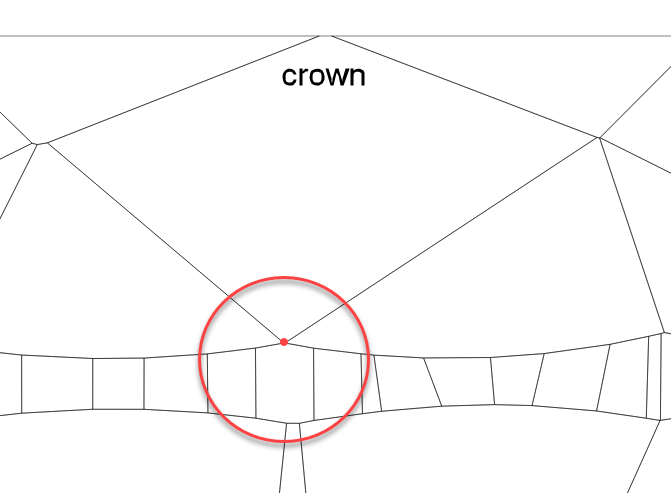
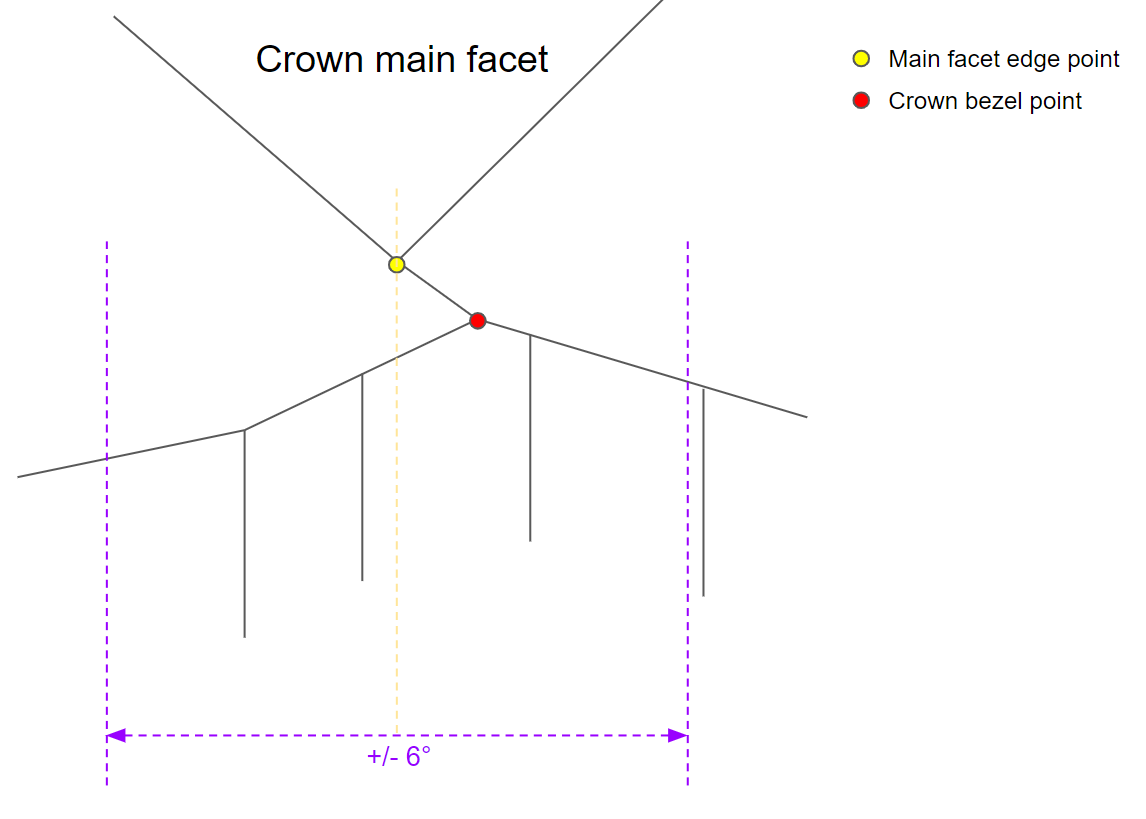
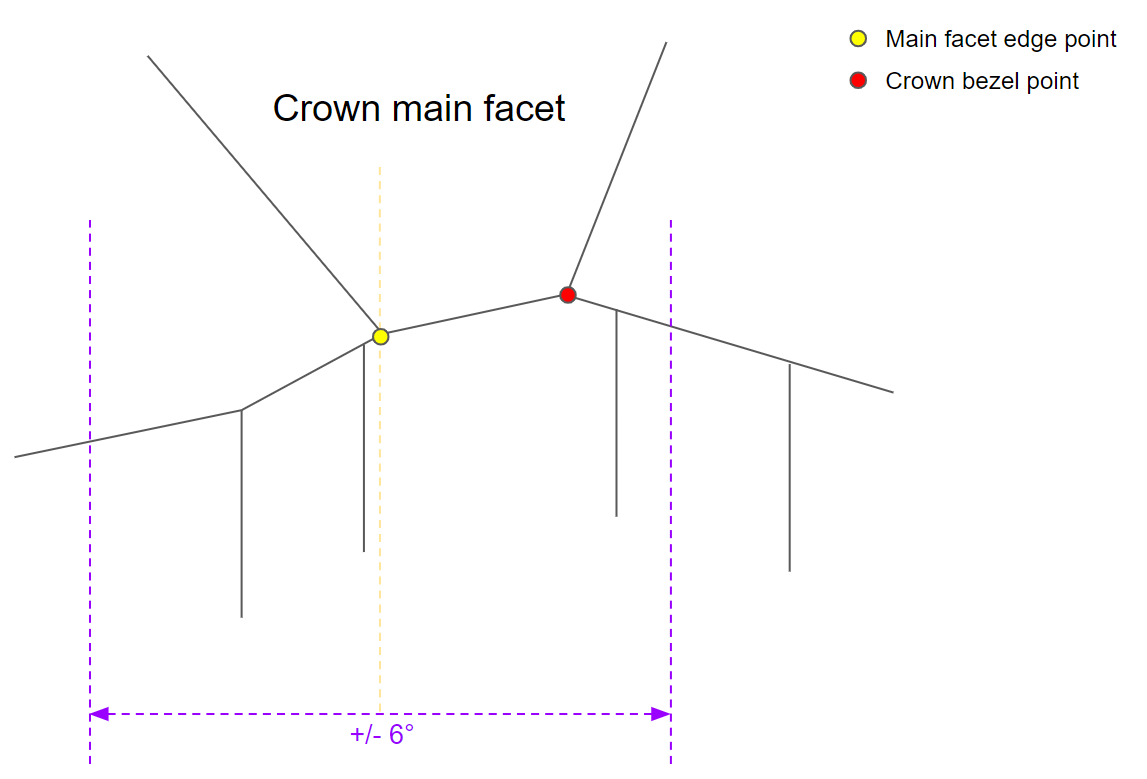
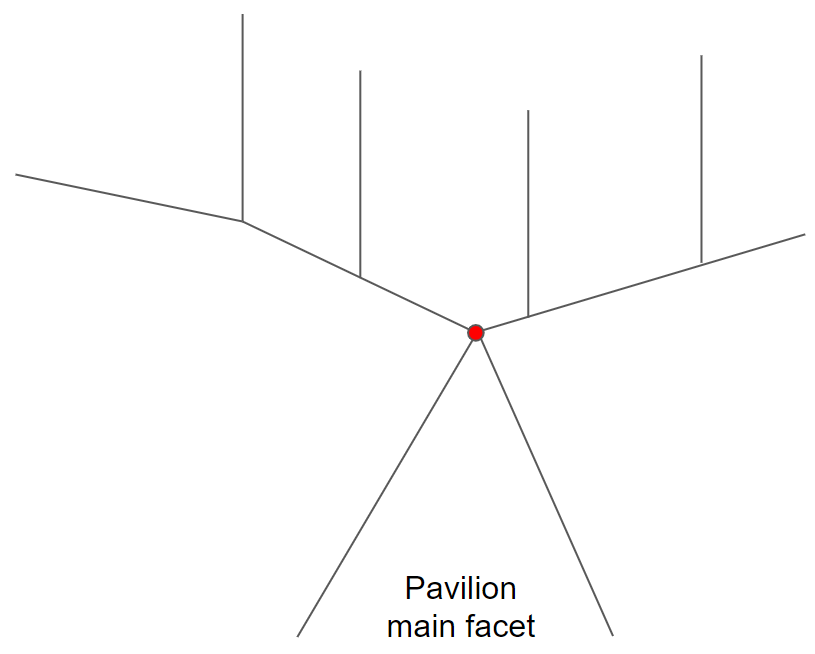
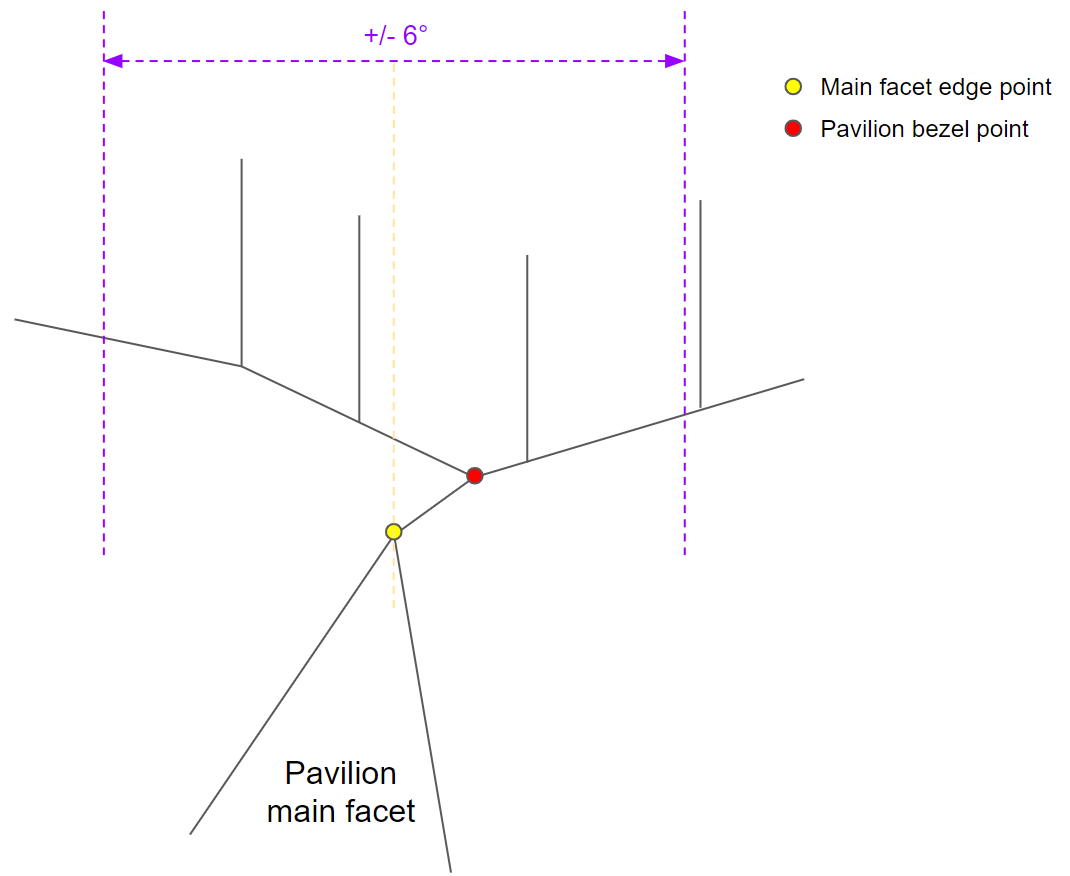
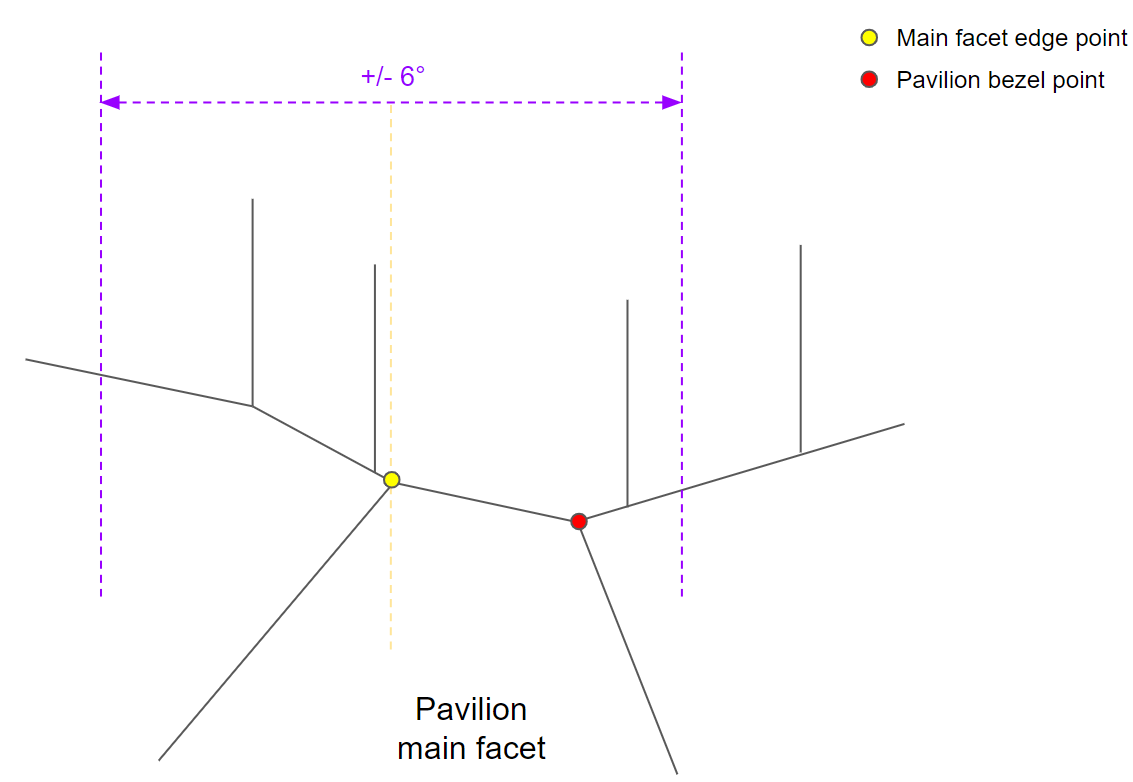
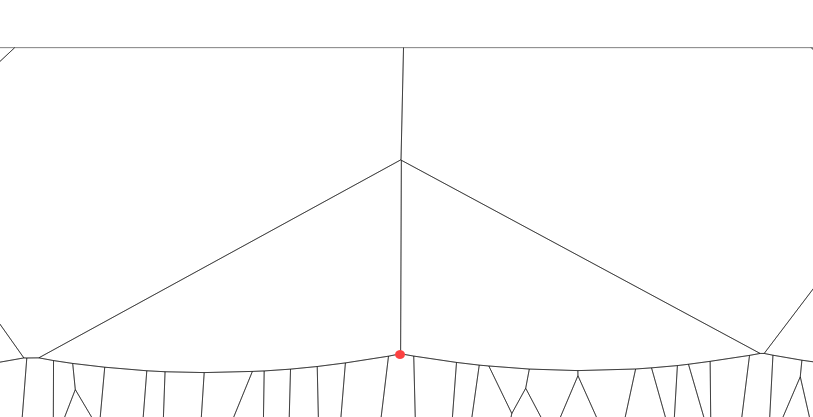
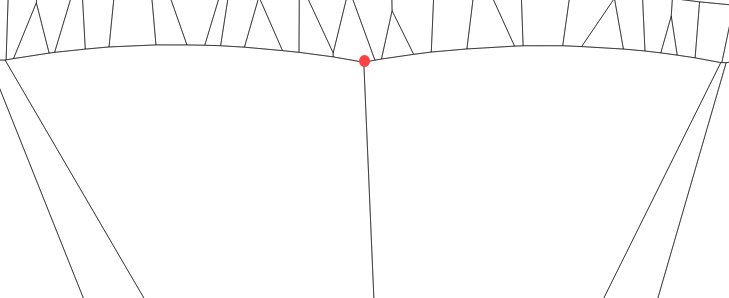
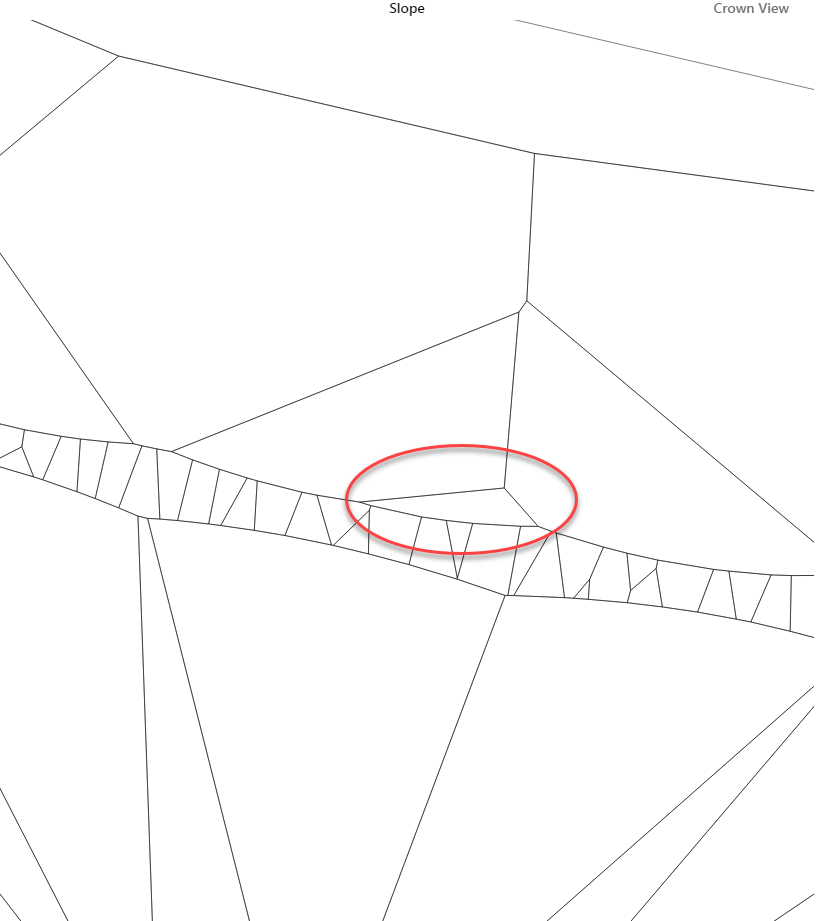
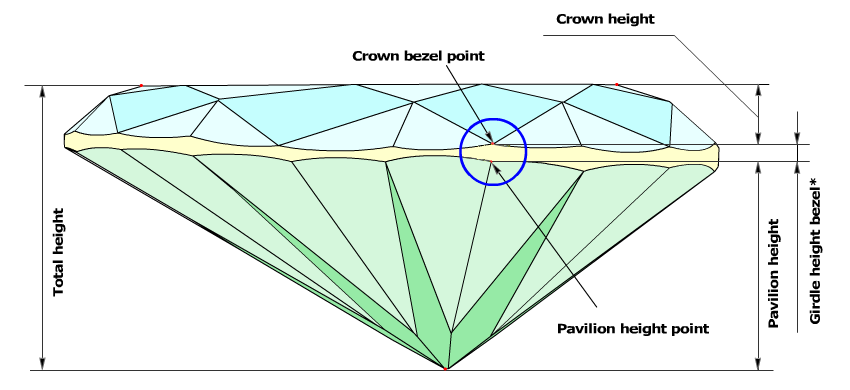
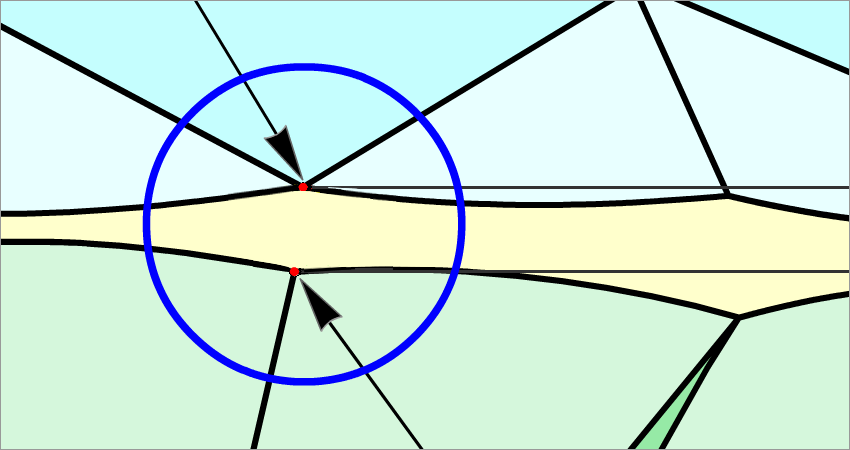
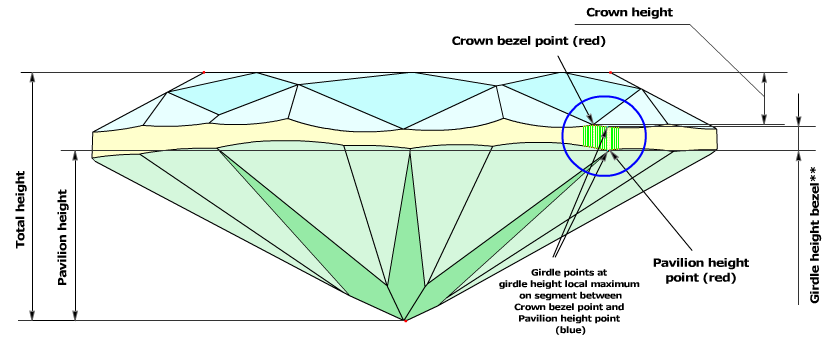
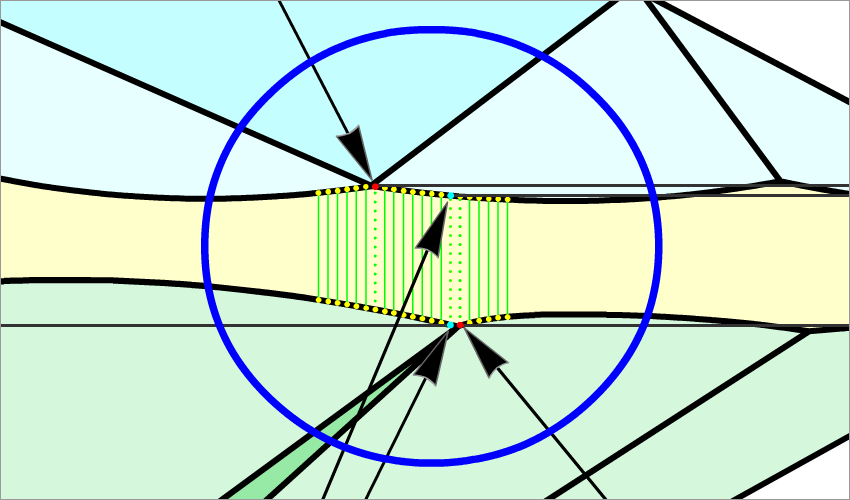
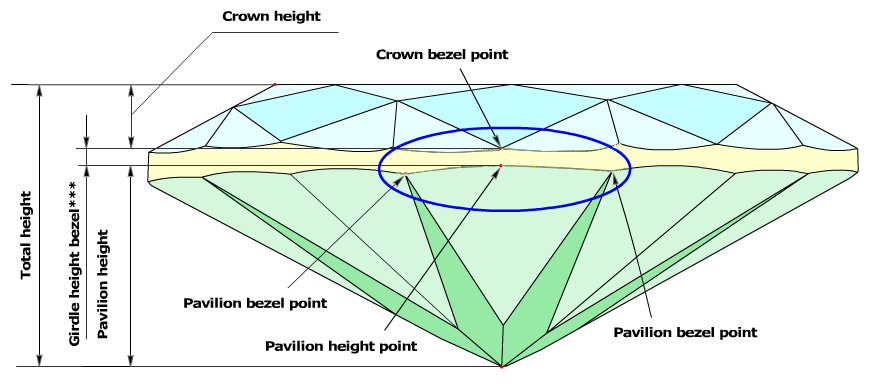
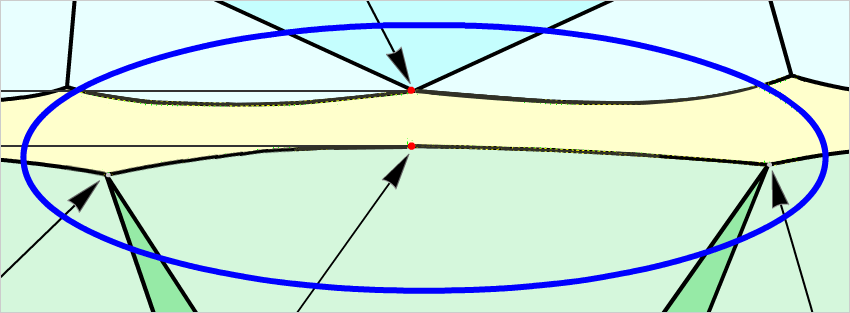
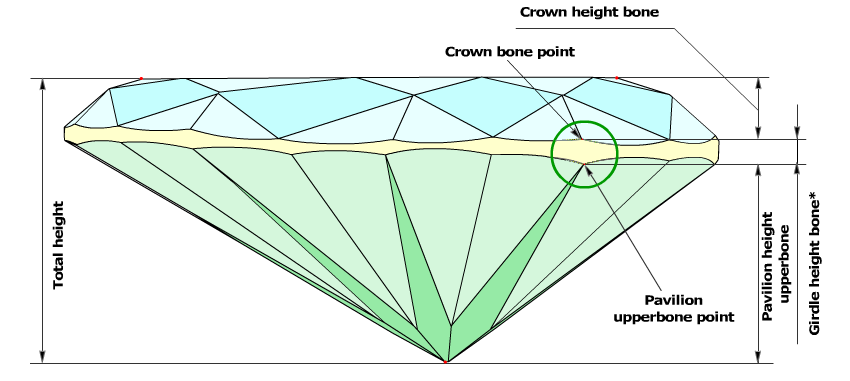
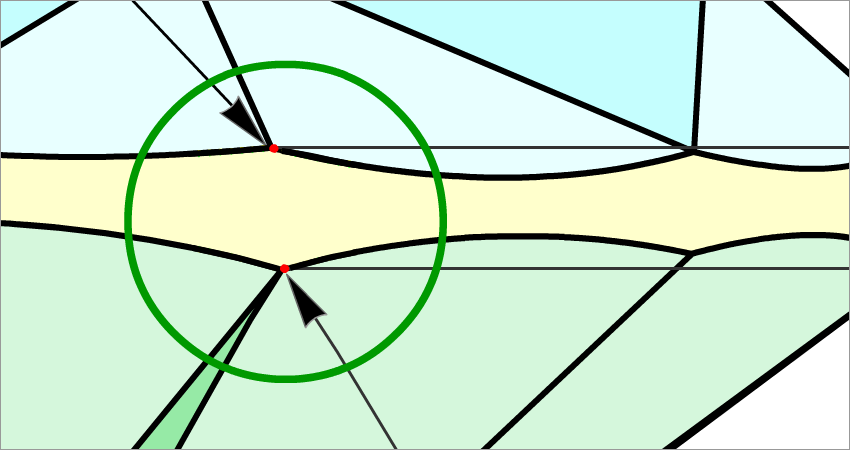
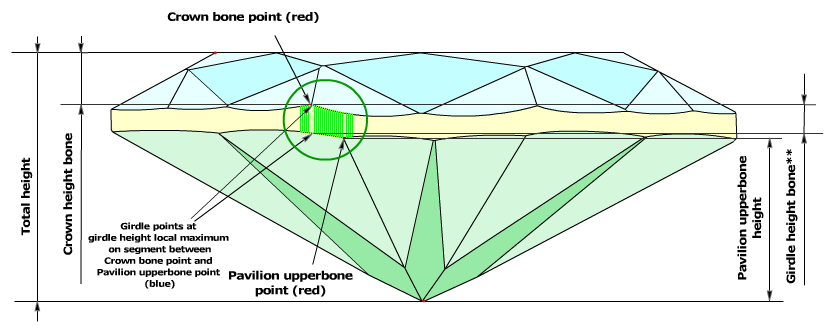
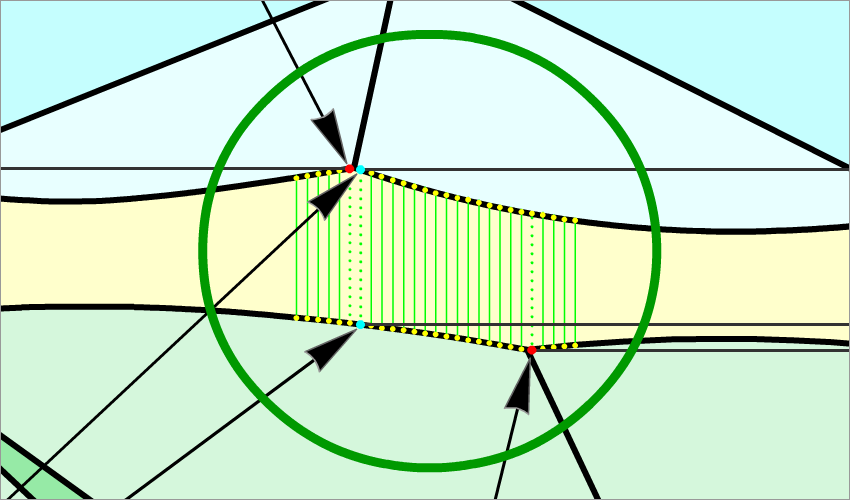
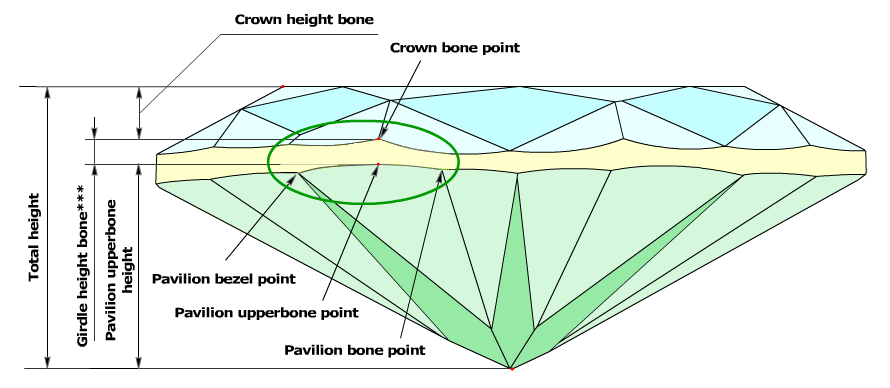
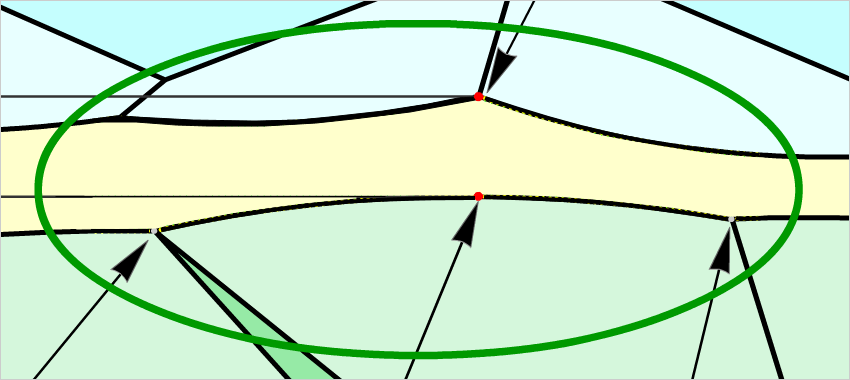
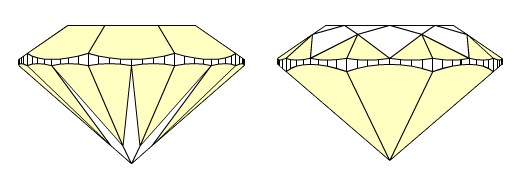





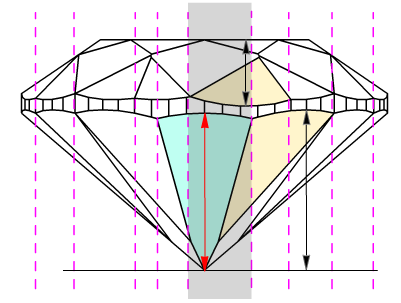
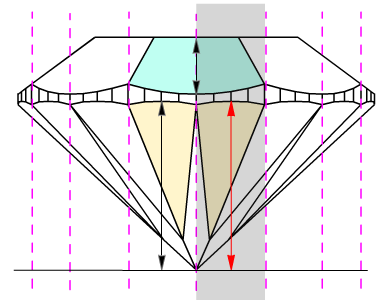
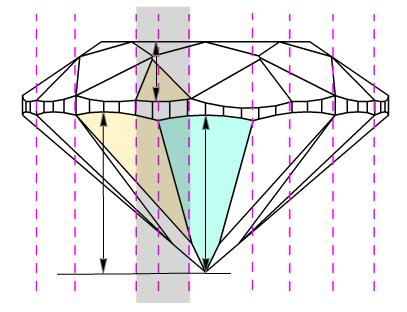

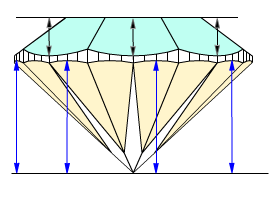
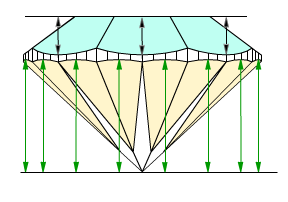
Add Comment